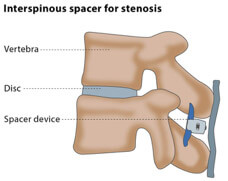Lumbar spinal stenosis is a common condition among individuals over 60 years old, and surgery for this condition is one of the most frequently performed procedures for the adult lumbar spine. The canal through which the spinal cord travels becomes narrow due to wear and tear of the spinal discs and joints, and the nerves that go through this narrowed canal may be compressed when the person stands or walks any distance, causing nerve tingling, pain, numbness, or weakness in the legs (this is called neurogenic claudication). Symptoms are relieved when the spine is flexed (when sitting or leaning forward). Bending forward creates a slight increase in the space where the spinal nerves are situated, thereby relieving symptoms.
Interspinous Spacers
Interspinous Spacers for Lumbar Spinal Stenosis
How Interspinous Spacers Can Relieve Leg Pain
This is where interspinous spacers come into play. Interspinous spacers are inserted between the bones in the back of the spine –called the spinous process— at the affected level of the spine, forcing this level into forward bending. This relieves pressure on the nerves, which leads to pain relief in the legs. The surgery is typically performed under local anesthesia but can also be done under a general anesthetic.
Many patients have reported significant pain relief after implantation of this device, and current evidence shows that these procedures are effective for carefully selected patients in the short and medium term, although failure may occur and further surgery may be needed.
It is essential that patient selection is carried out by specialist spinal surgeons who can offer patients a range of surgical treatment options.

Figure: Bending forward, or flexion in the affected level, creates a slight increase in the intraspinal space, and thereby relief of symptoms.
EUROSPINE is a society of spine specialists of various disciplines with a large knowledge of spine pathologies. All well-known and accepted treatment modalities for spine pathologies are represented by the members of the society. However, the Society cannot accept any responsibility for the use of the information provided; the user and their health care professionals must retain responsibility for their health care management.